The concept of the marketplace has entirely revolutionized the face of the global economy. Marketplace start-ups are eating entire industries and are experiencing great success in attracting buyers and sellers to their platforms.
The marketplaces are opening exciting opportunities for start-ups that want to make their app with unique ideas and business models. For example, Uber provides taxi services from private drivers instead of taxi hubs.
However, most of us misunderstood the marketplace concept as an eCommerce platform or drop-shipping model. Therefore, before building a marketplace app, let’s understand the concept of a marketplace in detail.
What Is A Marketplace?
The marketplace is a digital platform that aims to solve customers’ pain points by letting them connect with suitable service providers and sellers.
The marketplace concept works well with almost every niche and business model, from product selling to rentals to service offerings. eBay, Facebook marketplace, NextDoor, Tradesy, and OfferUp are some of the best examples of successful marketplaces.
Building Blocks Of The Marketplace App
The app comprises the following building blocks.
1. The marketplace backend
The backend part will determine the features and functionality of your app. Additionally, the backend will consist of a database that will store user data on your app.
2. The admin part
The admin panel is in the middle of your marketplace backend and user interface. The panel will inform all your marketplace activity and let you manage users, messages, notifications, and reviews.
Ensure to build your admin panel and its features simultaneously on the backend and graphical user interface.
3. The user interface
The UI is the design part of your app where users can interact with your platform through mobile devices and websites. Consider building different features and sections for sellers and customers, such as user profiles, listing pages, and content pages.
Types Of The Marketplace
There are many marketplaces, from the biggest ones like Amazon to small niche apps focusing on selling items under specific categories like courses or jewelry. The marketplace has been categorized in the following ways.
1. Marketplace based on a target audience
The marketplace has been categorized based on audience type.
I. B2B marketplace apps
The business focuses on businesses that want to purchase products from other companies. The platform consists of wholesale suppliers and vendors who wish to sell their services or products to other business owners, entrepreneurs, and resellers.
Best examples:
- Alibaba
- eWorldTrade
- SeeBiz
II. B2C marketplace apps
The platforms connect businesses directly to end customers. The platform charges a commission on every successful sale whenever buyers discover products and services and purchase them.
Best examples:
- Amazon
- Teachable
III. P2P marketplace apps
Marketplace under such categories and connects to individuals who want to enter a contract of exchange for products and services. For example, A listing platform where users can upload listings of their old products to sell them directly to other users.
P2P market apps allow users to become buyers or sellers at different times based on whether they want to buy or sell products.
Best examples:
- Airbnb
- Uber
- Etsy
- Quikr
- OLX
2. Marketplace types based on focus
The marketplace has been categorized based on niches and industries.
I. General or horizontal marketplace apps
The horizontal marketplace offers products across multiple categories. The platform under such categories offers a large group of products where sellers from different industries and segments can promote their products on the same platform.
Best examples:
- eBay
- Amazon
- Walmart
II. Niche marketplace apps or vertical marketplaces
The marketplace under such categories focuses only on a single industry or niche. However, vertical marketplaces also offer various products, but only relevant to specific industries, such as fashion, healthcare, grocery, etc.
Best examples:
- Airbnb
- Etsy
- Instacart
The Business Model Of The Marketplace App
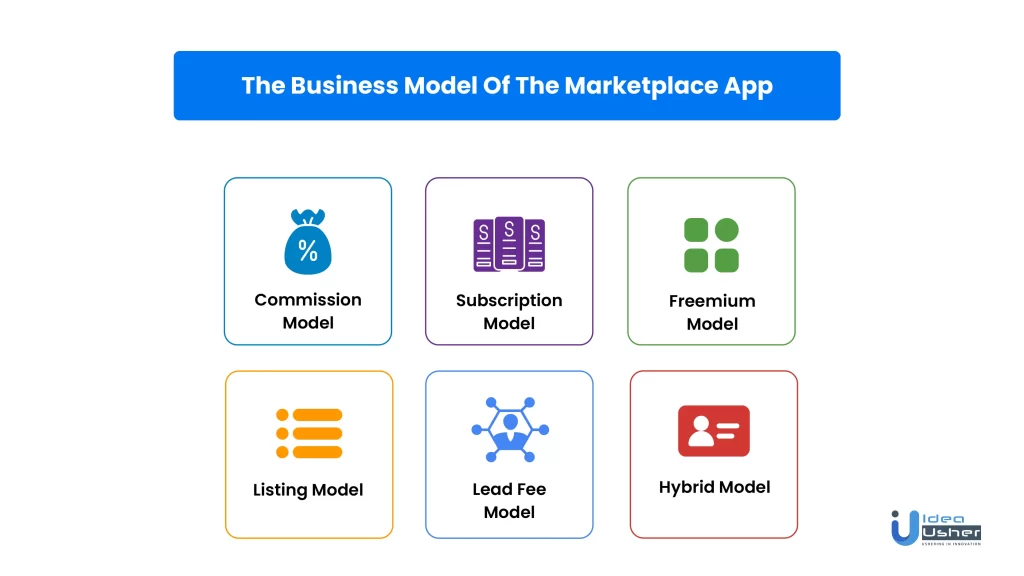
The marketplace reduces the gap between buyers and sellers by offering them a digital platform where they can connect with each other.
Most marketplaces make money by charging a commission or fee for every successful transaction from their users.
However, some other different revenue streams are also available by which the marketplace can generate revenue.
1. Commission model
The commission model is the major revenue source of the marketplace. The platforms get a fixed or variable commission on each successful order. Sellers pay a percentage-based commission on each sale.
The commission model allows the free joining of sellers where they only pay after each successful transaction happens through product selling.
Best examples:
- Amazon
- Airbnb
- eBay
- AppSumo
- Gumroad
2. Subscription model
This model includes charging membership fees based monthly or annually from their users. The platform offers valuable features to its customers to encourage them to renew their membership.
The subscription model includes common industries, including dating apps, learning platforms, real estate marketplace, etc.
Best examples:
- Home Exchange app
- OK Cupid
- Match.com
- LinkedIn Recruiter
3. Freemium model
The freemium model offers options to their users, such as either subscribing to their paid plan for additional features or using the app for free.
There are different ways to make money in freemium models, such as offering subscription plans or upselling and cross-selling available products and services.
Under the freemium model, buyers and sellers can access the platform without paying any fee but are limited to features and functionality.
Best examples:
- Freepik
- Craigslist
4. Listing model
The marketplace falling under the listing model charges money from its sellers for listing products or services on its platform. The seller on such platforms pays listing fees to the app owner to get visibility of their offerings.
The listing model ensures that the marketplace never misses out on popular items within the app.
Best examples:
- eBay
- Etsy
- Realtor
5. Lead fee model
The listing fee model is popular in the professional service industry. The platforms under this model charge money from the service provider in return for qualified leads they have generated from the platform.
On such platforms, users post their requirements, and professionals pay money to the marketplace for placing bids. Moreover, The platform also charges commissions whenever customers hire professionals to complete their job.
Best examples:
- Upwork
- Thumbtack
6. Hybrid model
The marketplace falling under the hybrid model includes combining different monetization models.
A hybrid marketplace business model depends on multiple revenue streams, such as listing fees, membership fees, commission fees, etc.
Best example:
- Etsy
How To Build A Marketplace App?
Building a marketplace involves complex processes, including market research, app development, project management, etc. Here is the step-by-step process to build your marketplace.
1. Define the project scope of your marketplace
You can define the project scope by considering the following factors.
- What market gap needs to be filled in your marketplace?
- B2B or B2C? What will be the business model of your marketplace?
- What are the required features you need to add to your marketplace?
- What is the USP (Unique Selling point) of your marketplace? To stand it out from the competition.
Prepare a detailed business plan outlining your vision, management team, objectives, and planned activities for your project.
Moreover, creating a business plan will help you attract investors by letting them easily understand your business plan by viewing your project scope.
2. Decide a suitable platform for an app launch
Decide the platform where you will provide accessibility to your marketplace. The suitable platform for your marketplace includes mobile devices such as iOS and Android and web apps.
Before deciding on the platform, understand your target audiences and identify the platforms where they are primarily active.
Once you identify a suitable platform based on your audience availability, you can proceed to app development by hiring a suitable company.
3. Hire an app development company
The better your team, the faster and smoother your app development journey. Hiring skilled app developers is crucial to successfully building and launching your app. However, hiring the best app developers needs technical expertise to screen their skills.
Consider outsourcing your marketplace project to an app development company. You can select the best company by checking their portfolios and past client feedback.
Also, check: How to hire app developers in 2023?
4. Platform design
The company you hire will design the following UI for your marketplace platform.
I. Build admin UI
The Admin UI is a web application from where you can control your entire marketplace.
Consider designing the admin panel part to facilitate you with monitoring the marketplace activity, controlling user accounts, or generating industry-relevant content.
II. Design marketplace UI
Based on your business needs, create the marketplace UI and the required features that customers and merchants can interact with. You can integrate the necessary API to expand the functionality of your marketplace even further.
Moreover, If you consider designing both the front-end and back-end using the same framework as Rails. In that case, it is worth building them both simultaneously by utilizing the interactive process.
5. Backend development
After designing the UI, the app development company will start backend development to make your platform fully functional.
I. Setting up app framework and database
The company will start backend development by building the skeleton of your application. They will follow the instructions of your chosen framework to install and configure your marketplace project’s framework.
Next, they will install a database and build a framework for basic features.
II. Design the database schema
The app development team will design the marketplace data architecture where the information will be searched, accessed, stored, and displayed.
Figuring out the essential entities for your marketplace platform is necessary to better manage your platform and relevant data. In the case of marketplace development, the essential entities for database schema are users, listings, and transactions.
III. Implement user accounts
The next crucial part of back-end development is building user account management with essential features like sign-up, login, and password reset capabilities.
IV. Implement listing management
Listing management features are an essential part of developing a marketplace. The feature will enable your merchants to
- Fill in the required product information.
- Customizing the listing page with additional data fields
- Defining listing availability
V. Implement a basic listing search
Enable your customers to search for their favorite products on your marketplace. You must define the key criteria your customer will use to search for relevant listings.
For example, an app like Airbnb has search listings based on location and capacity(number of beds).
You can improve the search functionality later by learning how your users interact with your marketplace and implementing additional features like keyword search and availability search.
VI. Building transaction process
Consider developing the initial transaction methods to determine how you’ll model the transaction process by answering the following questions:
- What is the procedure the customers and providers go through, and when will the payment happen?
- Do the merchants confirm customers’ requests happen automatically?
- What to do if a payment fails or if the payout to the seller fails?
- How will you handle declined requests and disputes?
- When will the transaction expire?
Next, determine how you will model the transaction process in your database. Identify how you will ensure consistency of transactions across many states, from state “requested-by-customer” to state “waiting-for-provider-to-deliver.”
VII. Implement reviews
Design a review feature to let users add their shopping experiences to your marketplace. Consider focusing on the following factors:
- At what stage do your users add reviews?
- Do the reviews need to be given in stars, ratings, or text?
- Would you ask for a review that won’t be visible to other users and will only be used to monitor or improve your marketplace?
VIII. Build availability management
Based on your marketplace type, the availability management will be based on day, time, or stock availability. The purpose of availability management is to:
- Prevent double bookings if customers already make a booking
- Help customers to search for products based on their availability
- Help users easily run their listings
Top Five Marketplace Platforms
It would always be best to study your competitors to gain an idea of their business model, best app features, USP, and others.
We have listed the best apps based on their listing fee, selling area, and other important factors.
1. eBay
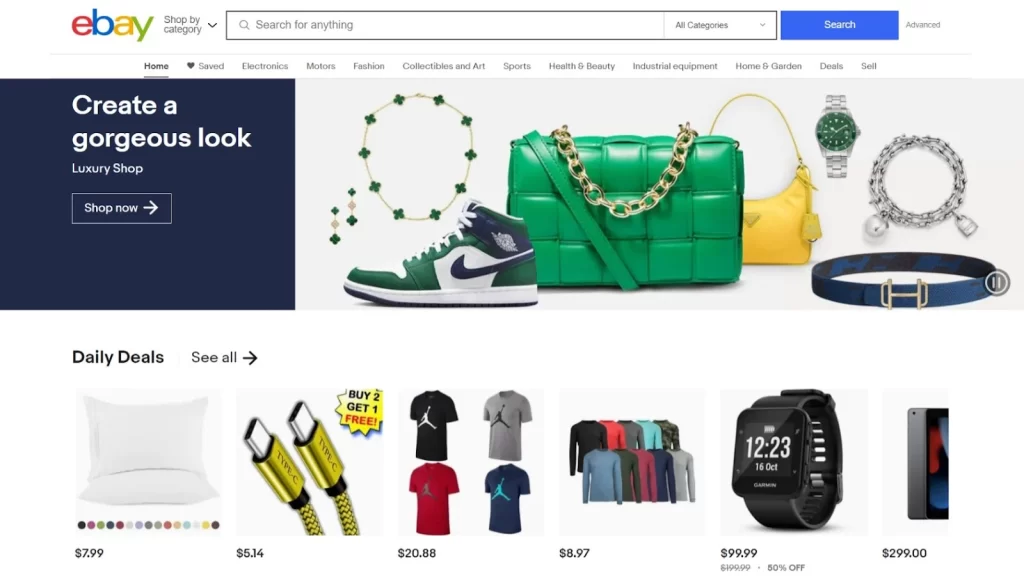
The platform is the best overall app for selling stuff, as the platform has over more than 147M users. The sellers can sell items either via auction or fixed-price listing. Moreover, the buyers can also place bids in increments higher than the last.
| Founded in | 1995 |
| Available on | Web, Android & iOS |
| App downloads | 10M |
| App ratings | 4.7 |
| Headquarters | California, United States |
| Developed by | Pierre Omidyar |
| Time to receive payment | 1-3 business days |
| Listing fee | Varies based on items, number of listings |
| Selling Area | Worldwide |
2. Nextdoor
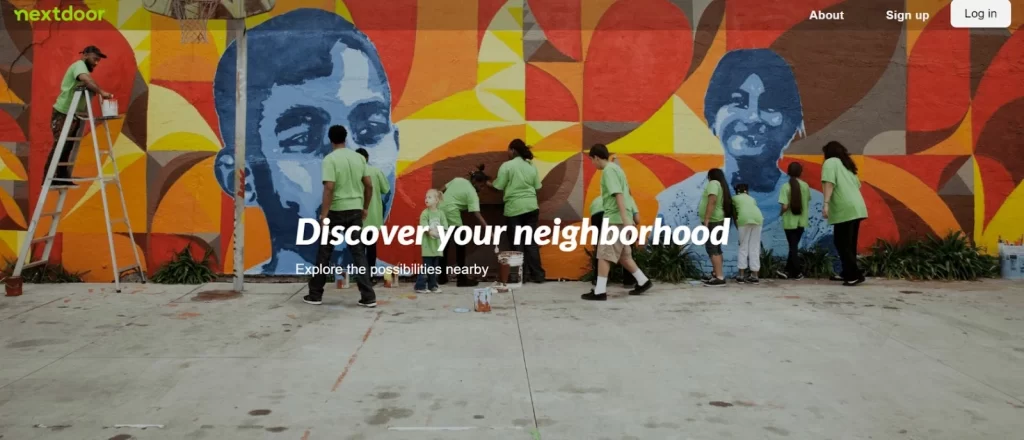
Nextdoor is the best platform for local sales because users can access listings nearby to their living areas. The platform offers a neighborhood-specific social network where users can sell items locally.
After sellers list their items on Nextdoor, their items will appear on neighbors’ newsfeeds of the users, even if they aren’t searching for items on sale.
| Founded in | 2008 |
| Available on | Web, Android & iOS |
| App downloads | 10M+ |
| App ratings | 4.5 |
| Headquarters | California, United States |
| Developed by | Nirav Tolia, Sarah Leary, Prakash Janakiraman |
| Time to receive payment | Varies |
| Listing fee | $0 |
| Selling Area | Local |
3. Meta Marketplace
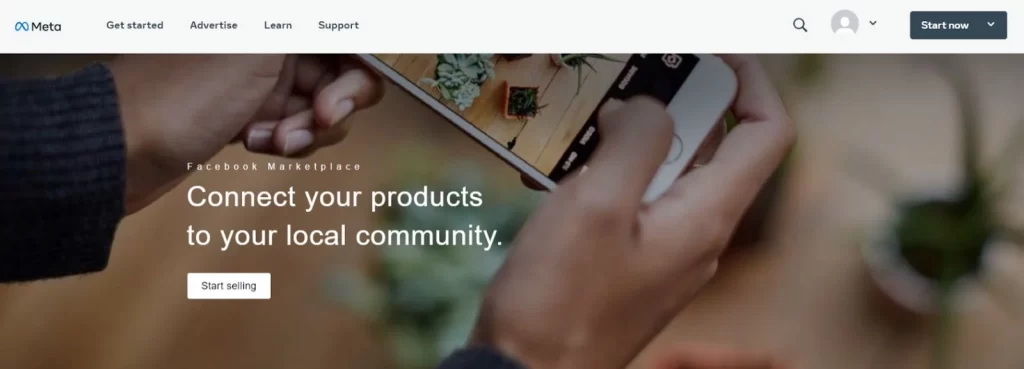
One of the popular marketplaces owned by “Meta,” where users can connect with local buyers and sellers.
The best part of Meta Marketplace is that listings on the platform are completely free. The platform offers users complete control over their listings, including price, time frame availability, and others.
| Founded in | 2004 |
| Available on | Web, Android & iOS |
| App downloads | 5B |
| App ratings | 3.2 |
| Headquarters | California, United States |
| Developed by | Mark Zuckerberg |
| Time to receive payment | Varies |
| Listing fee | $0 |
| Selling Area | Local |
4. OfferUp
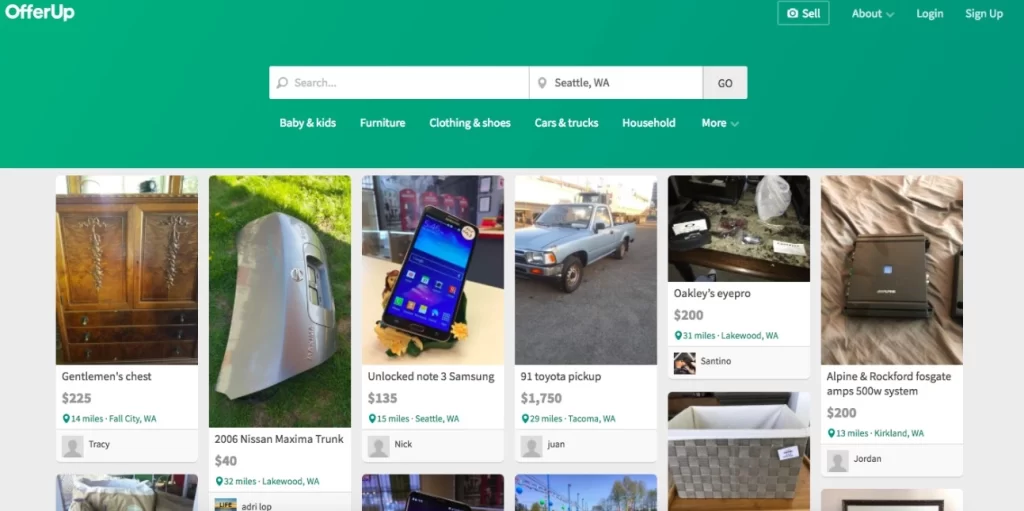
OfferUP enables users to sell anything from used cars to baby items to clothes. Users can decide whether to sell their items locally or worldwide.
Platform offers a more straightforward process of item listings where users can sell their products within 30 seconds of downloading the app.
The process includes uploading the photos of items, their input title, category, condition, item description, location, and price.
| Founded in | 2011 |
| Available on | Web, Android & iOS |
| App downloads | 50M |
| App ratings | 4.4 |
| Headquarters | Washington, United States |
| Developed by | Nick Huzar |
| Time to receive payment | 5-7 days |
| Listing fee | $0 |
| Selling Area | Nationwide |
5. Tradesy
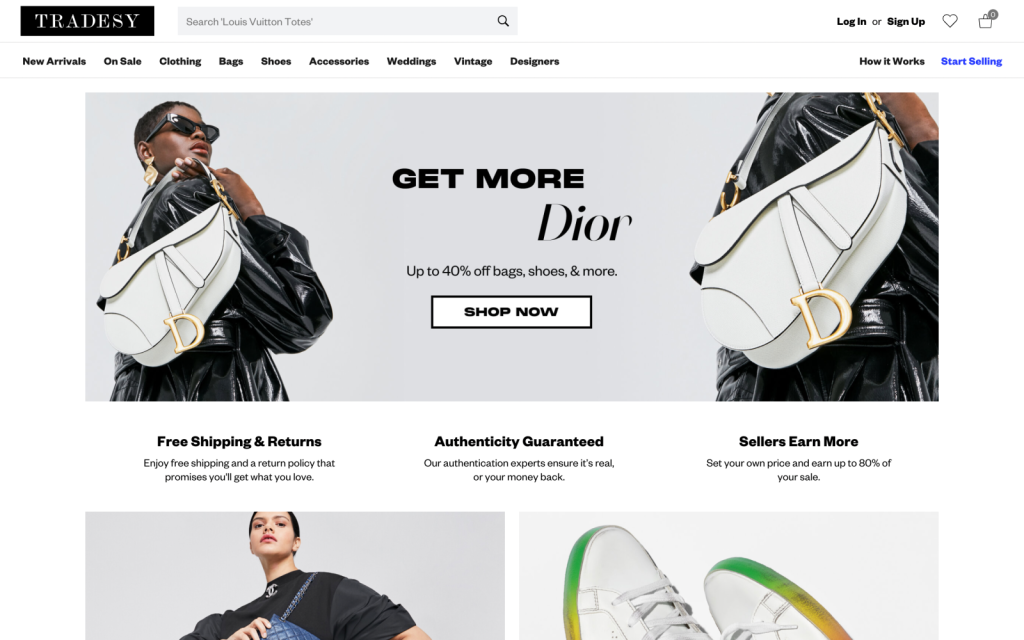
A luxury peer-to-peer shopping platform where users can quickly sell their designed items. Like OfferUp, Tradesy also offers an easier listing process where users need to upload a few photos of their items and information, including brand, size, condition, and selling price.
| Founded in | 2009 |
| Available on | Web, Android & iOS |
| App downloads | 100K |
| App ratings | 4.5 |
| Headquarters | California, United States |
| Developed by | Tracy DiNunzio |
| Time to receive payment | Up to 7 days from item delivery |
| Listing fee | $0 |
| Selling Area | Nationwide |
A Complete Feature List For Online Marketplace App
The following app features will create the MVP of your app (making it fully functional and ready to launch). However, you can include new features after an app launch to gain a competitive advantage.
The features are divided into separate panels.
1. Account & user profile management
There is a necessity to have both buyers and sellers with separate user profiles. You’ll need app flow for sign-up and profile creation for both user groups.
Although storing and keeping the user data safe and secure is crucial, along with keeping it compliant with local legal requirements.
- Sign in
- Login
- Email integration
- Verify email
- GDPR-Compliance
- Social logins (Facebook, LinkedIn, Github, Google, Twitter, etc.)
- User profiles (First name, last name, bio)
- Forgot password
- Change email
- Ban account
- Delete account
- Additional profile information
- Upload profile picture
2. Listing management
Having the availability of a wide range of products will help you attract more buyers to your platform. The listing management needs to be appealing, informative, and simple to let sellers easily upload their listings.
- Basic listing information: title, description, price
- Additional fields
- Update and delete listings
- Close listings
- Draft listings
- Listing approval
- Upload listing images
- Listing geolocation
- Pricing information
- Listing variations
3. Site search & discoverability
The following feature will enable your users to search for products they seek on your marketplace.
- Map
- Location search
- Location auto-complete
- Filtered search
- Keyword search
- Availability Search
- Listing Categories
4. Transaction process
The transaction process enables the user to make payments at different stages, such as making a booking request or leaving a review. You can include the following features based on your app type and objective.
- On-site messaging tools
- Notifications (email integration/SMS integration/push notifications)
- Cancellation policies
- Automatic Expiration
- Charging a commission
- Delayed payouts and refund management
- Pricing options (fixed/dynamic/seasonal/negotiation, add-ons)
- Invoicing
- Reviews after transaction
- Taxes
- PDF receipts
5. Booking & availability management
Offering powerful features to your sellers is the best way to attract worldwide sellers and make your platform available with various products.
To make your marketplace stand out, give your sellers a powerful feature to manage their offerings.
- Booking calendar for buyers
- Availability management calendar for sellers
- Support for different time zones
- Ability to filter a search by availability
- Handle Daylight Savings changes etc.
- Stock management
- Seats
6. Payment integration
Simplifying the payment process is the best way to generate more sales on your platforms.
The payments in marketplaces are subjected to all kinds of regulations that traditional e-commerce avoids. All the sellers receive payouts on the marketplace as paying money is easy, but payouts are hard, especially global payouts.
Payouts are challenging as they are subjected to all kinds of regulation, including fraud prevention and anti-money laundering legislation.
You can simplify the payout process in the given ways.
- Choose a payment method that accepts the countries, payment types, and currencies you require
- Take care of strong customer authentication and 3D security
- Refund
- Create an integration with the aid of Webhooks, Redirect and Return URLs, and API access.
- Confirm and accept cash
- Delay in payment
- Flow for enrolling sellers that comply with Know Your Customer (KYC) standards
- split payments between the marketplace and the seller
7. Admin features
The admin console will act like an app with exclusive features. The admin panel will help you to manage activity, know about your users, and identify the areas of improvement for boosting conversion, retention, and transaction quality.
- Intuitive Admin UI
- User search
- User account status
- Managing products or services that are being sold
- Access to all user-generated content
- Access to messages
- User management
- Ability to manage transactions
- Notification management
8. Marketing & communication
The features and functionality for marketing and communication will depend on your marketplace idea and the audience’s needs. However, the basic features of marketing and communication will be as follows.
- Email integration
- SEO
- CRM
9. Hosting, monitoring, and security
After building your marketplace, regular maintenance is crucial. You’ll need to hire a full-time DevOps developer to manage and maintain your marketplace architecture.
Additionally, you’ll need robust security and performance monitoring for your marketplace and scale them automatically or manually in case of traffic spikes. Consider giving priority to the following factors.
- Hosting (e.g., AWS or Heroku)
- Maintenance
- Audit logs
- Security and privacy
- Performance monitoring
- Error tracking
- Logging
- Alerting when the app is unavailable / performing slowly
- Scalable data storage
- Auto-scaling (or at least the ability to scale manually in case of traffic spikes)
Technology Stack For Developing A Marketplace App
The technology stack you will select will determine the quality of your final product. Therefore, you should select the appropriate tools for your app development carefully.
We suggest you consult an app development company to help you select the right tech stack. However, the basic tech stack for building your marketplace development will be as follows, which may vary based on your project needs and budget.
| Mobile platforms | Android, iOS |
| Programming language | Kotlin for Android, SwiftUI for iOS |
| Framework | Ruby on Rails, Phoenix, Nest.js |
| Database | Firebase, PostgreSQL |
| Cloud environment | Azure, Google, AWS |
| Database | Firebase, PostgreSQL |
| Payment Gateways | Apple Pay, Android Pay, PayPal, Braintree, Stripe |
| Push notifications | Firebase, APNs, Amazon SNS |
| Real-time chat feature | Websockets, Sidekiq, Twilio |
How Much Does It Cost To Build A Marketplace App?
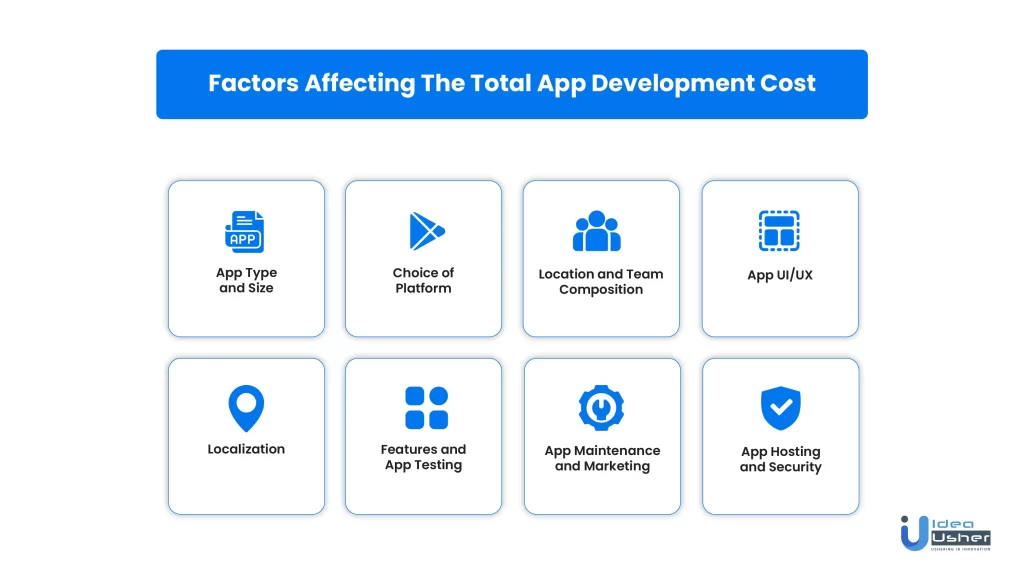
The overall cost of building a marketplace may be affected by many factors, such as:
1. Application type and size
The size of the application falls under three types such as small, medium, and big. Mobile app development with small size may require less app development budget.
The budget may increase with respect to the app size as the app starts including additional features and API integration, which require more effort from app developers.
Moreover, mobile apps with large sizes need big-size databases and more scalable hosting solutions, which increase the app development budget even further.
The cost of building a marketplace varies depending on the app types, such as database-driven mobile apps, hybrid mobile apps, native mobile apps, simple functionality mobile apps, etc.
2. Platform selection for app development
The platform chosen for app development will be decided by the company’s strategy. The strategy will be based on many factors, including audience demographics, utilizing device-specific features such as Apple App’s clips, etc.
Moreover, the platform selection will also depend on the app development approach, that is, hybrid app development or native web development.
3. Team structure and location
The team structure and location of an app development company are other factors that can affect your app development budget.
The company has a qualified team structure with years of expertise in app development across different industries and can charge you higher fees than other companies that just recently established their team structure.
However, we suggest proceeding with an app development company with years of experience in building high-quality digital products.
A basic and primary app development team comprises a project manager, programmer, QA engineer, and UI/UX developer. While an extended team comprises a project manager, two app developers, one system administrator, one backend developer, and one QA engineer.
On the other side, the locality of the app development company is another factor that can affect your app development budget.
It has been noticed that app development companies from Asian countries charge lower app development fees than companies from Western countries, with little to no difference in delivering the quality of mobile apps.
4. App UI/UX
The excellent user interface and user experience for your marketplace are critical to its success. Your application must have excellent UI/UX component likes, push alerts, visual pictures, customization, and icons.
Building an excellent UI/UX platform for your marketplace need efforts from highly skilled UI/UX designers. Therefore, the complexity of your app design is another factor that can affect your app development budget.
5. Localization
Tapping into a global market needs additional support for popular languages. Therefore, language localization is another factor that can affect your app development budget.
By offering support in many languages, you can reach more people by letting them access your platform in native languages.
6. App features and testing
The success of your online marketplace will strongly depend on the features and values you will deliver to your users. The more features you will include in your app, the more your app-building budget will exceed.
Along with implementing features, proper app testing is critical to ensure your marketplace is free from technical glitches or any other drawbacks.
App testing includes the involvement of app testing tools and effort from app developers or beta testers. Therefore app testing is another factor that will affect your app-building budget.
7. App maintenance and marketing costs
Maintaining and marketing your marketplace is another significant expense factor you need to add to your budget. The app maintenance includes releasing new updates with new features and fixing bugs to ensure the proper functioning of an app.
On the other hand, you can grow your business through marketing practices such as SEO, content marketing, social media marketing, etc.
8. App hosting and security
Consider app hosting and maintaining its security as another important factor in your app development budget.
Mobile applications need to exchange massive amounts of data, including user search data, employee data, company private transactions, and much more.
Therefore, purchasing dedicated servers with cutting-edge multi-layer security measures for your marketplace is crucial.
However, purchasing a dedicated server is costlier than shared hosting but can offer greater platform security.
Offering a secure environment to your marketplace can help you build and maintain your user trust. You can incorporate multiple security solutions, such as multilayer authentication and others, to gain your user’s trust and provide a secure and safe marketplace.
Are You Ready To Build Your Marketplace App?
The demand for marketplace apps is growing, offering businesses the opportunity to target many profitable industries with their marketplace development.
However, developing a marketplace platform needs years of expertise in app development that only a reliable app development company can have.
Instead of hiring independent developers, hiring an app development company is a great way to simplify your app-building process.
The company comprises years of experience building mobile apps across different industries with Agile or other preferred app development methodologies.
So, if you’re looking for a company to help you build a marketplace, look no further than Idea Usher. Contact us today to understand how we can help bring your app idea to life.
Contact Idea Usher
Work with Ex-MAANG developers to build next-gen apps schedule your consultation now
Email:
Phone:
FAQ
Q. What are some of the marketplace app features?
A. The required features of your online marketplace are Account and user profile, Booking and availability management, Admin panel, Listing management, In-app search, Payment integration, Marketing and communications tools, Transaction Management, Monitoring, and security.
Q. What is a marketplace app?
A. The marketplace is a digital platform that facilitates the trading of goods and services. The app provides a digital platform for both merchants and customers where they can connect.
Q. How do marketplace apps make money?
A. The marketplace makes money from business models such as the Commission model, Lead fee model, Hybrid model, Subscription model, Freemium model, and Listing model.
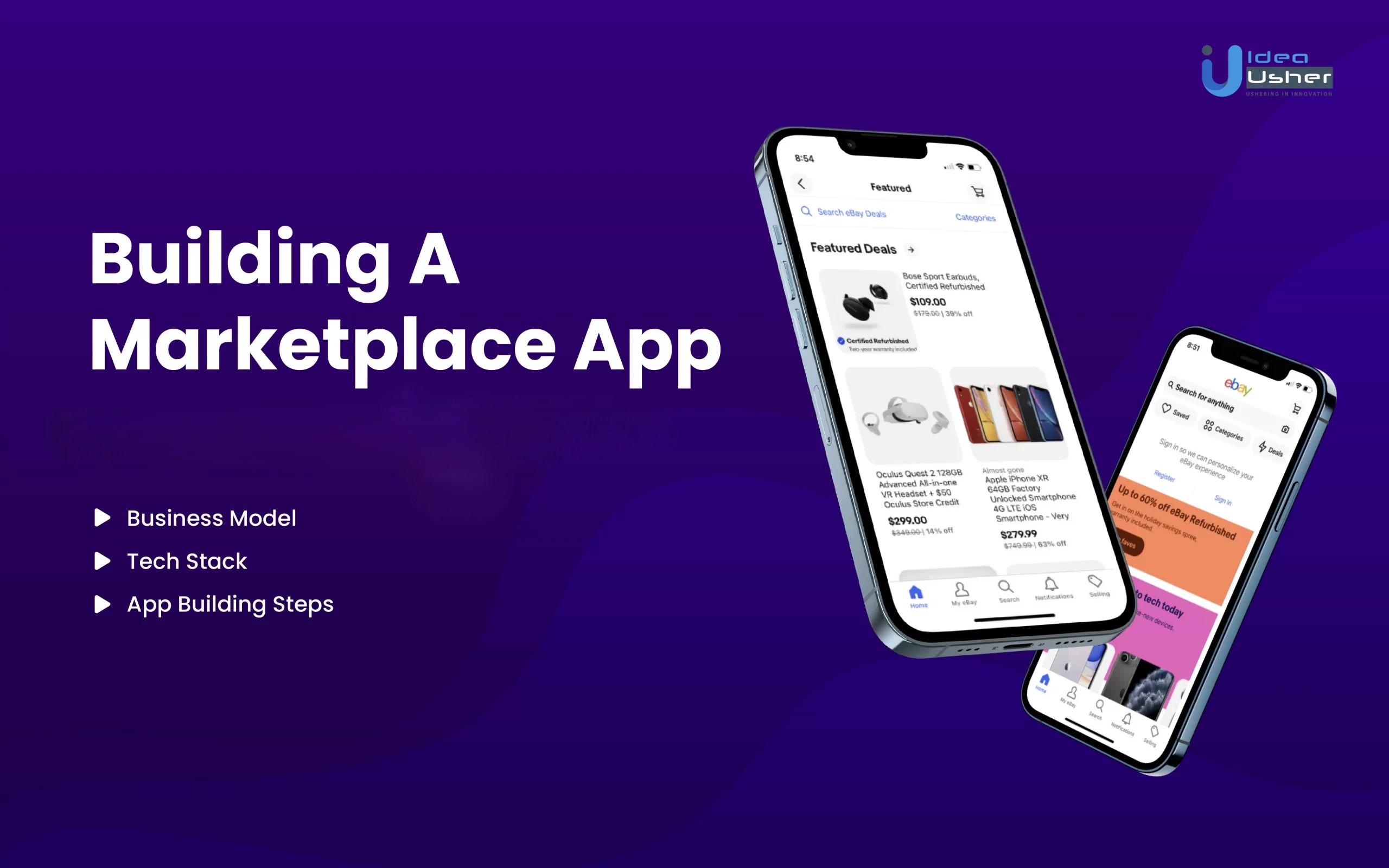














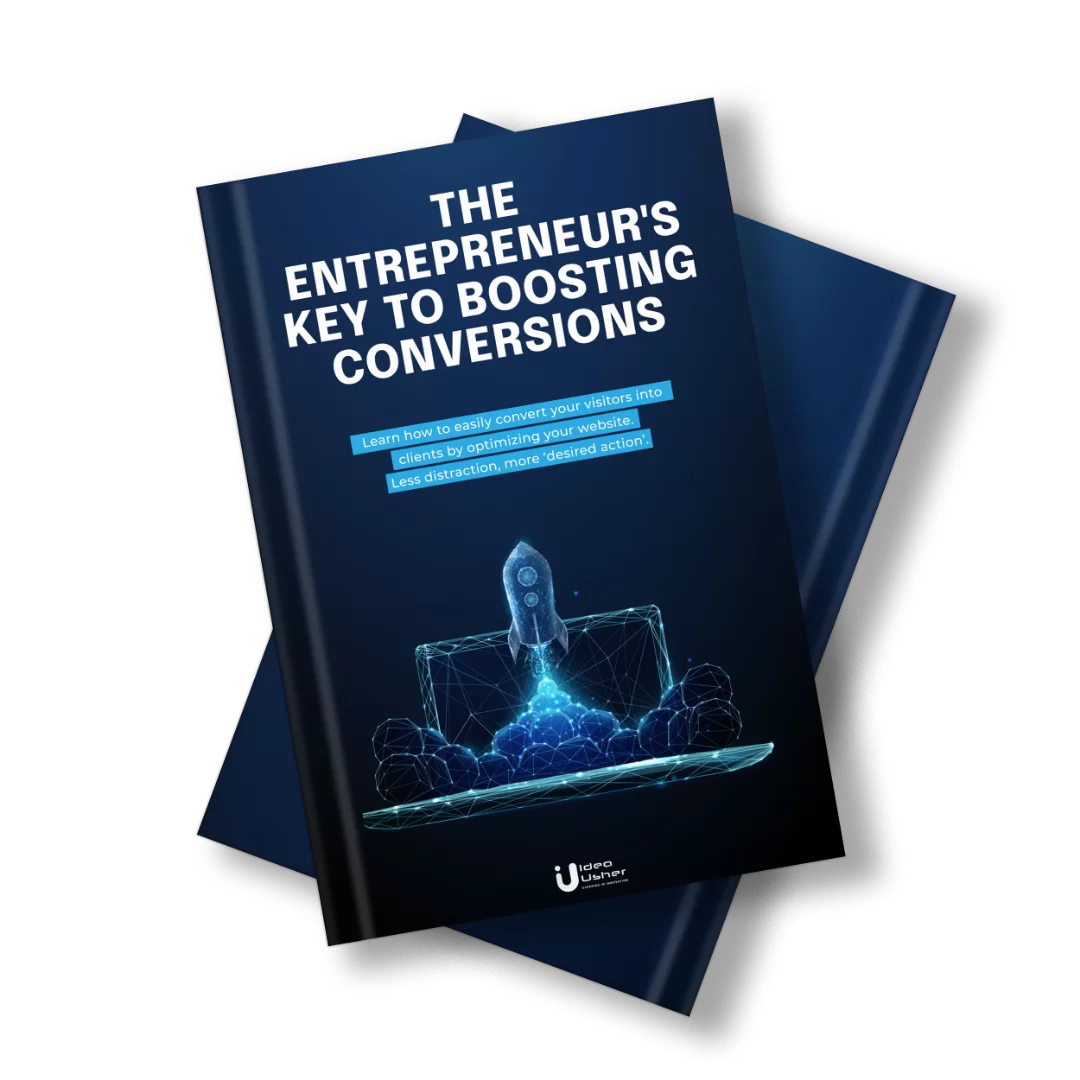
 Can I help you?
Can I help you?
